Are you struggling to find the perfect yard material for your dog’s potty area?
Do you want to create a space that is both clean and safe for your furry friend?
Look no further!
In this article, we will guide you through the best yard materials for a dog potty area and provide essential tips for usage.
Get ready to discover the ultimate solution to your dog’s bathroom needs!
Click Here to Jump to a Section
Key Takeaways:
- There are various yard materials that can be used for a dog potty area.
- Using the right yard material can ensure cleanliness and safety for your pet.
- Each yard material has its advantages and disadvantages, so it’s important to choose the one that suits your needs.
- Proper maintenance is crucial to keeping the dog potty area clean and odor-free.
- Consider your dog’s preferences and habits when selecting a yard material for their potty area.
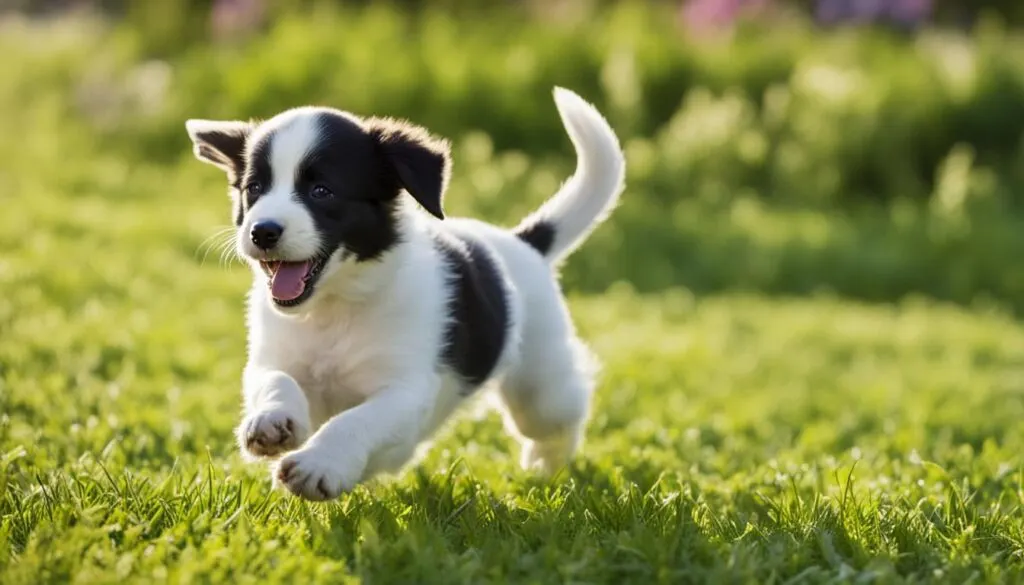
Importance of a Dedicated Dog Potty Area
Having a dedicated dog potty area in your yard is essential for both you and your furry companion.
Not only does it provide convenience and hygiene, but it also offers several other benefits that contribute to a clean and comfortable environment.
1. Better Organization and Convenience
A dedicated dog potty area helps you maintain a more organized yard.
By designating a specific spot for your dog’s bathroom needs, you can easily keep the rest of your yard clean and free from unwanted messes.
This organized setup also ensures that you won’t accidentally step on any surprises while enjoying your outdoor space.
2. Health and Hygiene
Creating a dedicated dog potty area promotes good hygiene practices.
By consolidating your dog’s waste in one designated spot, it becomes easier to clean and dispose of properly.
Regularly removing waste from the dedicated area reduces the risk of bacterial growth and prevents unpleasant odors from permeating your yard.
3. Training and Routine
A dedicated dog potty area helps establish a consistent routine for your furry friend.
Dogs thrive on routine, and having a designated spot for bathroom breaks reinforces the behavior you want to encourage.
This routine simplifies the training process, making it easier for your dog to understand where they should go when nature calls.
4. Preserving your Yard
A designated dog potty area helps protect the rest of your yard from wear and tear.
Concentrating urine and waste in a specific location prevents damage to your grass, plants, and other landscaping elements.
By preserving the rest of your yard, you can maintain its aesthetic appeal and avoid costly repairs or replacements.
| Benefits of a Dedicated Dog Potty Area: |
|---|
| 1. Better organization and convenience for your yard |
| 2. Health and hygiene benefits for both you and your pet |
| 3. Establishing a consistent routine for your dog’s bathroom breaks |
| 4. Preserving the rest of your yard from damage |
By creating a dedicated dog potty area in your yard, you provide a clean and convenient space for your pet’s bathroom needs. This not only benefits you by preserving your yard and keeping it tidy but also ensures the overall well-being and comfort of your furry companion.
Synthetic Grass for Dog Potty Area
When it comes to creating a dog potty area in your yard, synthetic grass is a popular and practical choice.
This section will explore the advantages of using synthetic grass, along with tips on installation and maintenance to ensure optimal usage.
Advantages of Synthetic Grass
Synthetic grass offers several benefits that make it an ideal yard material for a dog potty area.
Firstly, it requires minimal maintenance compared to natural grass.
You can say goodbye to mowing, watering, and fertilizing, saving you time and effort.
Additionally, synthetic grass is highly durable and can withstand heavy foot traffic and pet activities without getting worn out.
Its realistic appearance also adds an appealing aesthetic to your yard.
Installing Synthetic Grass
Installing synthetic grass for your dog potty area can be a straightforward process.
Start by clearing the area of any debris and ensuring the ground is level. Then, lay a weed barrier to prevent weeds from growing through the grass.
Next, unroll the synthetic grass and secure it in place using landscape staples or adhesive. Trim any excess grass to fit the desired area.
Finally, infill the grass with silica sand or rubber granules to provide stability and prevent odors.
Maintaining Synthetic Grass
Maintaining synthetic grass in your dog potty area is relatively simple.
Regularly remove solid waste by picking it up or using a pooper scooper. Rinse the area with water as needed to wash away any residual urine.
It’s also advisable to occasionally spray an odor-neutralizing solution to keep the area fresh.
Additionally, brush the grass blades with a stiff bristle brush to restore their upright position and prevent matting.
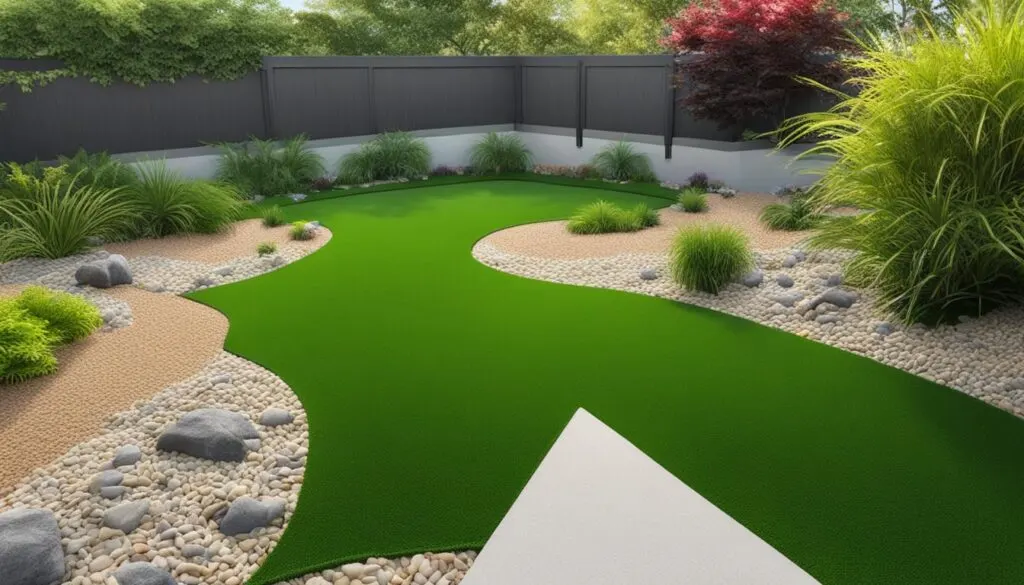
With its low maintenance requirements, durability, and realistic appearance, synthetic grass is an excellent choice for a dog potty area in your yard.
By following the installation and maintenance tips mentioned above, you can create a clean and comfortable space for your furry friend to do their business.
Gravel and Pea Gravel for Dog Potty Area
Gravel and pea gravel are excellent choices for creating a dog potty area in your yard.
These materials offer a range of benefits, including superb drainage, effective odor control, and easy cleaning.
Let’s explore why gravel and pea gravel are ideal options for your dog’s bathroom needs.
Benefits of Gravel and Pea Gravel
1. Excellent Drainage: Gravel and pea gravel have natural permeability, allowing urine to pass through quickly.
This prevents the formation of puddles and ensures a dry and clean surface for your pet.
2. Odor Control: The porous nature of gravel and pea gravel helps minimize odors by allowing the urine to flow away and be naturally absorbed into the ground.
This helps maintain a fresh-smelling dog potty area.
3. Easy Cleaning: Gravel and pea gravel can be easily cleaned by hosing down the area or using a pet-friendly disinfectant.
The loose nature of these materials makes it simple to remove solid waste for proper sanitation.
Selecting the Right Gravel
When choosing gravel for your dog potty area, consider the following factors:
- Type: Opt for rounded gravel or pea gravel to provide a comfortable surface for your dog’s paws.
- Size: Select a gravel size that is small enough for easy cleaning but large enough to prevent it from sticking to your pet’s fur.
- Quantity: Calculate the amount of gravel required based on the size of the dog potty area and the desired thickness of the gravel layer.
- Quality: Ensure the gravel is free from sharp edges and contaminants that may harm your pet.
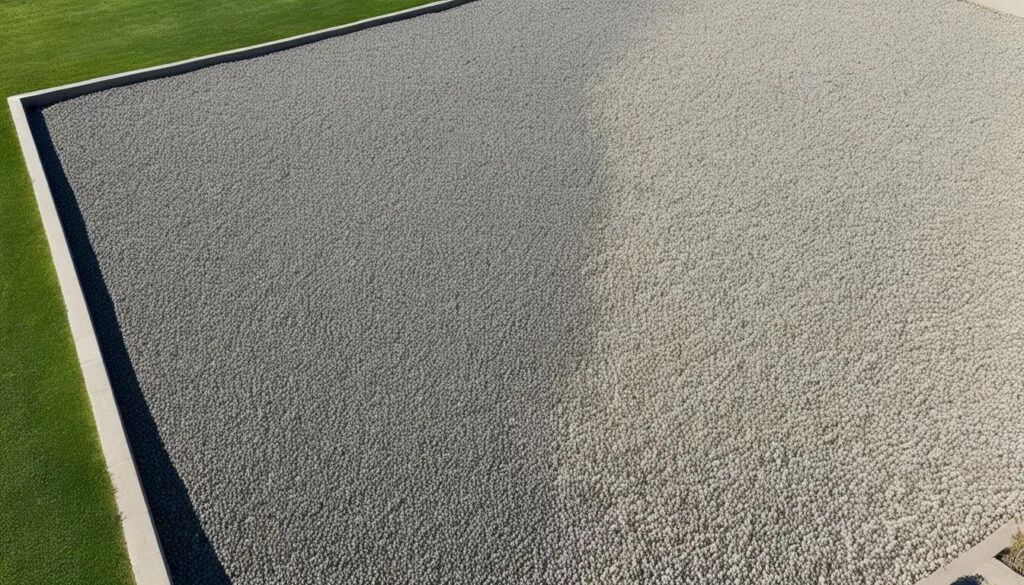
Incorporating gravel or pea gravel into your dog potty area provides a functional and visually appealing solution. Let’s take a look at a comparison table highlighting the key features of both materials.
| Feature | Gravel | Pea Gravel |
|---|---|---|
| Drainage | Excellent | Excellent |
| Odor Control | Effective | Effective |
| Comfort | Good | Excellent |
| Cleaning | Easy | Easy |
As you can see, both gravel and pea gravel offer similar benefits. It ultimately comes down to personal preference and aesthetic considerations.
Ensure the selected material is suitable for your dog’s comfort and your maintenance preferences.
In the next section, we will explore another yard material option for a dog potty area – porous paving. Stay tuned!
Porous Paving for Dog Potty Area
When it comes to creating a dog potty area in your yard, one material that stands out is porous paving.
This innovative solution offers several benefits that make it ideal for pet owners.
Let’s explore why porous paving is an excellent choice and how you can install and maintain it effectively.
Benefits of Porous Paving
Using porous paving in a dog potty area provides numerous advantages:
- Proper Drainage: The porous nature of the paving allows rainwater and urine to seep through, preventing the formation of puddles that can create a messy environment.
- Puddle Prevention: With its ability to drain water quickly, porous paving helps in avoiding the accumulation of stagnant water, ensuring a clean and dry space for your furry friend.
- Odor Minimization: The porous material helps in reducing odors by allowing air circulation and preventing urine from stagnating on the surface.
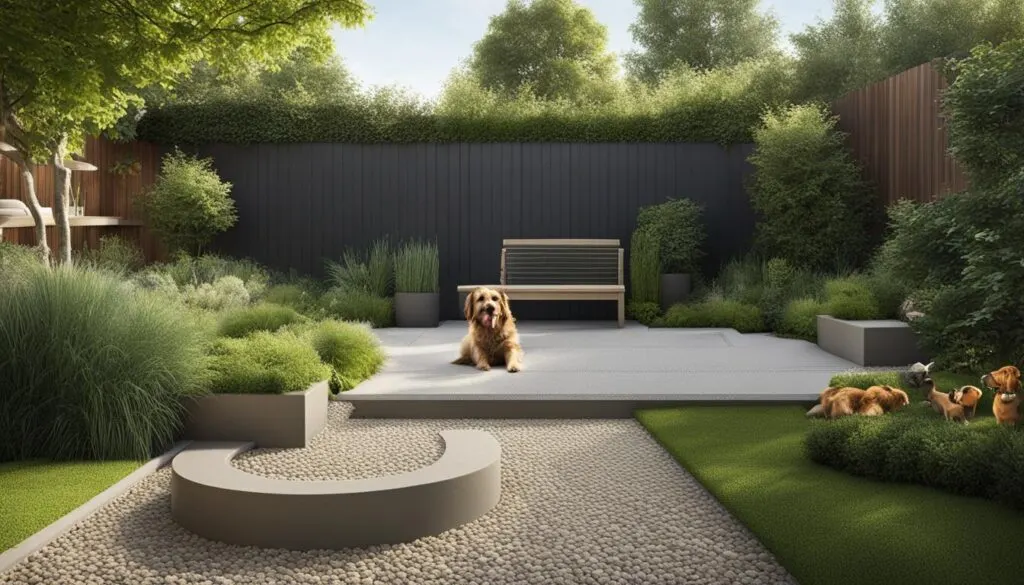
Installation and Maintenance Tips
Here are some installation and maintenance tips to ensure optimal usage of porous paving in your dog potty area:
- Prepare the area: Clear the designated area and ensure it is free from debris and vegetation.
- Level the ground: Make sure the ground is level before installing the porous paving to prevent any uneven surface.
- Install the paving: Follow the manufacturer’s instructions for installing the porous paving properly.
- Regular cleaning: Rinse the surface of the paving with water regularly to maintain cleanliness and minimize odors.
- Deep cleaning: Occasionally, use a mild detergent mixed with water to deep clean the surface and remove any stubborn stains or odors.
By utilizing porous paving in your dog potty area, you can create a clean and odor-free space for your pet’s bathroom needs.
Its unique properties ensure proper drainage and minimize odors, resulting in a hygienic environment for both you and your furry companion.
| Porous Paving for Dog Potty Area | Benefits |
|---|---|
| Proper Drainage | Prevents puddles and maintains a clean environment |
| Puddle Prevention | Drains water quickly, avoiding stagnant water |
| Odor Minimization | Reduces odors by allowing air circulation and preventing urine stagnation |
Natural Grass Options for Dog Potty Area
In this section, we will explore various options for using natural grass in a dog potty area.
Natural grass provides a more familiar and comfortable experience for your furry friend.
We will discuss three popular options: sod, grass patches, and grass seed, highlighting their advantages and considerations for installation and maintenance.
Sod
Sod is an excellent option for creating an instant and lush dog potty area.
It consists of pre-grown grass, usually in rolls or squares, that can be installed directly onto the designated area.
The benefits of using sod include:
- Immediate results: With sod, you can quickly establish a fully grown and green dog potty area.
- Less maintenance: Sod requires less watering and seed germination time compared to other natural grass options.
- Durability: Sod is resilient and able to withstand frequent use and pet traffic.
When installing sod, it’s important to prepare the soil properly and ensure adequate watering and regular maintenance for optimal growth and health.
Follow the manufacturer’s instructions for installation and maintenance specific to the type of sod you choose.
Grass Patches
Grass patches are an alternative option for creating a natural grass dog potty area.
These patches come in various sizes and can be easily placed and replaced as needed. Here are some advantages of using grass patches:
- Flexibility: Grass patches can be moved or rearranged to different areas of your yard, allowing you to maintain a fresh and clean dog potty area.
- Cost-effective: Grass patches are often more affordable compared to sod, making them a budget-friendly choice.
- Easy maintenance: Grass patches require regular watering and occasional trimming to keep them in good condition.
When selecting grass patches, consider the size of your dog and the area you want to cover.
Choose patches made from durable and pet-friendly grass varieties for long-lasting usage.
Grass Seed
Grass seed is another option for establishing a natural grass dog potty area. This method requires more time and patience but offers long-term benefits.
Consider the following advantages of using grass seed:
- Coverage customization: Grass seed allows you to control the coverage and density of the grass in your dog potty area.
- Cost-efficiency: Grass seed is typically the most affordable option for establishing a large dog potty area.
- Renewability: With grass seed, you can easily replenish and regrow the grass as needed.
When using grass seed, it’s crucial to follow proper seeding techniques, including soil preparation, regular watering, and protection against pest or weed damage.
Ensure the grass seed is suitable for your climate and dog’s activities.
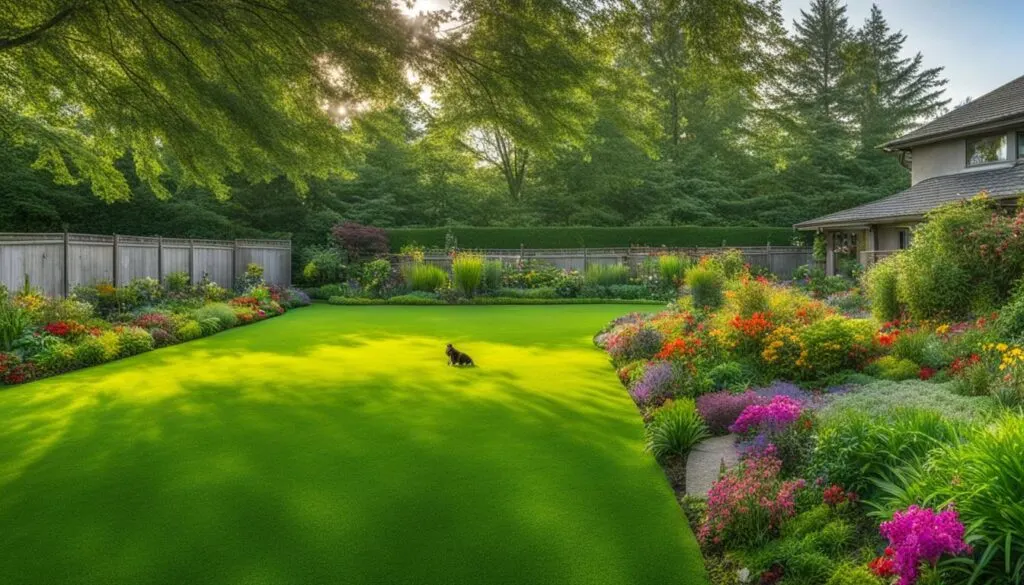
| Natural Grass Options | Advantages | Considerations |
|---|---|---|
| Sod | Immediate results | Proper soil preparation and maintenance required |
| Grass Patches | Flexibility and cost-effective | Regular watering and occasional trimming needed |
| Grass Seed | Customizable coverage and cost-efficiency | Time and patience required for growth |
Artificial Turf for Dog Potty Area
When it comes to creating a dog potty area in your yard, artificial turf is a fantastic option to consider.
It offers numerous benefits that make it a popular choice among pet owners.
Let’s explore why artificial turf is an excellent yard material for your dog’s bathroom needs.
Durability and Longevity
One of the key advantages of artificial turf is its durability.
Unlike natural grass, artificial turf can withstand heavy use and doesn’t require frequent reseeding or patching.
It is specially designed to resist wear and tear, ensuring a long-lasting and reliable solution for your dog’s potty area.
Low Maintenance
Artificial turf is incredibly low maintenance, making it a convenient choice for busy pet owners.
You can say goodbye to mowing, fertilizing, and watering.
Simply rinse off any waste or debris with water, and your dog’s potty area will stay clean and fresh.
Additionally, artificial turf doesn’t attract pests like natural grass, reducing the need for insecticides.
Odor Control
One of the most significant concerns when it comes to a dog potty area is controlling odors.
Artificial turf is designed with innovative technologies that minimize unpleasant smells.
The specialized infill and drainage system allow urine to drain away quickly, preventing the buildup of odor-causing bacteria.
With artificial turf, you can enjoy a fresh and odor-free outdoor space.
Choosing and Installing Artificial Turf
When selecting artificial turf for your dog’s potty area, consider the pile height and density.
A shorter pile height is recommended as it makes it easier to clean and maintain.
Additionally, choose artificial turf with good drainage capabilities to ensure proper waste removal.
Proper installation is crucial for the longevity and performance of the artificial turf.
Prepare the base by removing any existing vegetation and leveling the area.
Install a geotextile fabric to prevent weed growth. Then, lay the artificial turf securely, ensuring it is tight and well-anchored.
Follow the manufacturer’s instructions for infill application and maintenance.
With artificial turf as your yard material, you can create a durable, low maintenance, and odor-controlled dog potty area.
Your furry friend will have a consistent and comfortable space to answer nature’s call, while you enjoy a stress-free and clean outdoor environment.
Mulch for Dog Potty Area
When it comes to creating a dog potty area in your yard, mulch can be a fantastic option.
Not only does it provide a natural and aesthetically pleasing look, but it also offers several benefits for both you and your furry companion.
In this section, we will explore the advantages of using mulch as a yard material for a dog potty area and provide insights on selecting the right type of mulch and maintaining it effectively.
Advantages of Mulch
- Mulch is organic and non-toxic, making it a safe option for your pet.
- It has excellent absorbency, effectively soaking up urine and preventing unpleasant odors.
- Mulch provides a soft and comfortable surface, mimicking the feel of natural grass.
- It helps control weeds, reducing the need for frequent maintenance.
- Mulch retains moisture, keeping the potty area cooler in hot weather.
In addition to these benefits, mulch can also enhance the overall appearance of your yard, creating a cohesive and visually appealing space for your pet’s bathroom needs.
Selecting the Right Mulch
When choosing mulch for your dog potty area, it’s important to consider a few factors:
- Opt for organic mulch, such as wood chips or bark, to ensure it is pet-safe.
- Avoid using mulch with sharp edges that may cause discomfort to your dog’s paws.
- Choose a mulch that is easy to clean and maintain.
- Consider the color of the mulch to complement the surrounding landscape.
By selecting the right mulch, you can create a comfortable and visually appealing potty area that seamlessly blends with your yard.
Maintaining Mulch for Dog Potty Area
Maintaining mulch in a dog potty area is relatively simple. Follow these tips to keep the area clean and odor-free:
- Rake and turn the mulch regularly to prevent odor buildup.
- Replace soiled or heavily saturated mulch as needed.
- Spot clean the area with dog-friendly disinfectant sprays to maintain hygiene.
- Keep the mulch layer at an appropriate depth to ensure proper absorbency.
Regular maintenance will help ensure that your dog’s potty area remains clean and odor-free, providing a comfortable space for them to do their business.
Now that you know the advantages of using mulch for a dog potty area and how to maintain it effectively, you can create a safe and pleasant environment for your furry friend.
Concrete or Flagstone for Dog Potty Area
When it comes to choosing the right yard materials for your dog potty area, concrete and flagstone are both excellent options to consider.
These durable materials offer several benefits that can enhance the functionality and aesthetics of your pet’s designated bathroom space.
Benefits of Concrete for a Dog Potty Area
Concrete is a popular choice for dog potty areas due to its durability and ease of cleaning. Here are some key advantages:
- Strong and long-lasting, able to withstand heavy foot traffic and pet activity
- Resistant to scratches, digging, and pet damage
- Smooth surface allows for easy waste removal and cleanup
- Does not absorb odors or stains
Benefits of Flagstone for a Dog Potty Area
If you prefer a more natural and visually appealing option, flagstone is an excellent choice. Here’s why:
- Natural and earthy appearance that blends well with outdoor surroundings
- Durable and resistant to cracking
- Offers a textured surface that provides grip and prevents slipping
- Allows for natural drainage of rainwater and urine
When using concrete or flagstone for your dog potty area, it’s essential to create a comfortable and safe surface for your pet.
Consider adding a layer of pet-friendly turf or artificial grass to provide a soft and welcoming texture.
| Materials | Benefits |
|---|---|
| Concrete |
|
| Flagstone |
|
Using Dog Potty Pads and Trays in the Yard
If you’re looking for an alternative solution for creating a dog potty area in your yard, consider using dog potty pads and trays.
These products offer convenience, easy maintenance, and effective odor control, making them a popular choice among pet owners.
Dog potty pads are absorbent pads designed to resemble grass, providing a comfortable and familiar surface for your furry friend.
They are particularly useful for dogs who are accustomed to going potty on grass but don’t have access to real grass in their yard.
Potty pads are also ideal for situations where maintaining a natural grass area is challenging.
Dog potty trays, on the other hand, are designed to hold real or synthetic grass, offering a more realistic outdoor experience for your dog.
They provide a designated area for your pet to relieve themselves, eliminating the need for constant cleanup and ensuring a clean yard.
When using dog potty pads and trays in your yard, follow these tips for optimal usage:
- Choose a suitable location in your yard for the potty pads or trays.
- Ensure the area is easily accessible for your dog.
- Place the potty pads or trays on a flat and stable surface to prevent tipping or shifting.
- Change the potty pads regularly to maintain hygiene and prevent odors.
- Clean the dog potty trays regularly to ensure cleanliness and odor control.
With dog potty pads and trays in your yard, you can create a dedicated space for your pet to relieve themselves while maintaining a clean and odor-free environment.
These products offer convenience and easy maintenance, making them a practical solution for pet owners.
General Tips for Maintaining a Dog Potty Area
Once you have set up a dog potty area in your yard, it’s important to maintain it regularly to ensure a clean and hygienic space for your pet.
Regardless of the specific yard material you’ve chosen, here are some general tips to help you maintain a healthy and pleasant environment:
Cleaning
Regular cleaning is crucial for maintaining a dog potty area.
Remove solid waste daily using a scooper or waste bag, and dispose of it properly. For synthetic grass or porous paving, rinse the area with water to eliminate urine residue.
Natural grass and mulch may require periodic mowing and raking to keep them tidy.
Odor Control
To keep unpleasant odors at bay, consider using odor-neutralizing products specifically designed for dog potty areas.
These products help eliminate odors and provide a fresher environment for both you and your furry friend. Frequent cleaning and proper drainage also contribute to minimizing odor buildup.
Proper Waste Disposal
When disposing of waste, always follow local regulations and guidelines.
Bag and seal any solid waste before placing it in a designated waste bin or trash bag.
Liquid waste should be allowed to drain properly or absorbed by the yard material, depending on the type used.
Regular Inspections
Regularly inspect your dog potty area for any signs of damage or wear.
Check for loose or damaged materials, excessive odor, or areas that may need reseeding.
Promptly addressing any issues will help maintain the functionality and appearance of the area.
Consider Changing the Layout
If you notice consistent wear or if the area becomes difficult to maintain, consider changing the layout of your dog potty area.
This could involve rotating the location, resizing the area, or even exploring alternative yard materials that better suit your pet’s needs.
By following these general tips, you can ensure a well-maintained dog potty area that promotes cleanliness and provides a comfortable space for your furry companion.
| Tip | Description |
|---|---|
| Cleaning | Remove solid waste daily and rinse the area to eliminate urine residue. |
| Odor Control | Use odor-neutralizing products and maintain proper drainage to minimize odors. |
| Proper Waste Disposal | Bag and seal solid waste before disposing of it and follow local regulations. |
| Regular Inspections | Inspect the area for damage, odor, or areas that need maintenance. |
| Consider Changing the Layout | If necessary, modify the layout to better suit your pet’s needs. |
Final Thoughts
Congratulations on exploring the best yard materials for a dog potty area and learning how to use them effectively!
By creating a dedicated space with the right materials, you can provide your furry friend with a clean and safe area for their bathroom needs.
Whether you choose synthetic grass, gravel, porous paving, natural grass, artificial turf, mulch, concrete, or flagstone, each material has its own advantages and considerations.
Consider your pet’s needs, your yard’s characteristics, and your preferences when selecting the most suitable material.
Remember to follow the usage tips mentioned throughout the article and maintain the dog potty area regularly to ensure a happy and healthy environment for your beloved pet.
Regular cleaning, proper waste disposal, and odor control measures are essential to uphold cleanliness and hygiene.
With the right yard materials and proper maintenance, you can create a comfortable and convenient dog potty area that will benefit both you and your canine companion.
Enjoy a hassle-free and enjoyable experience while keeping your yard clean and your pet happy!
